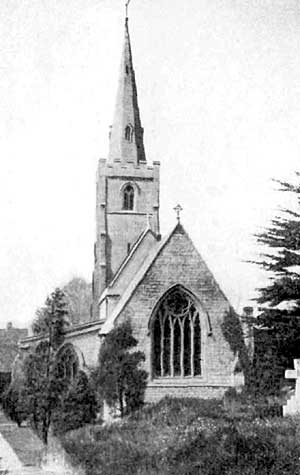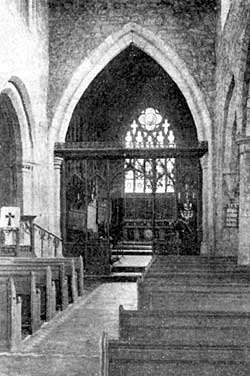THE PARISH CHURCH OF ST. MICHAEL, SUTTON BONINGTON.
BY THE REV. R. O. YEARSLEY.
 ST. MICHAEL'S, SUTTON BONINGTON.
ST. MICHAEL'S, SUTTON BONINGTON.This church has been much altered from time to time, but enough of the ancient work remains to determine the dates of the various parts, and they may be taken as follows:
The nave arcades are the earliest portion of the existing church, and are of the Early English period, probably erected early in the 13th centnry. The pillars on the north side have their bases spread out so as to form stone seats. This is the case in a good many churches of the same period, prior to the introduction of benches into the body of the church. Such seats served as a means of rest and support for the aged and infirm during the long services of the church.
About 1340 or 1350 the side aisles were rebuilt, probably much wider than before, their present width being very great compared with that of the nave. A large south porch was also built, which had a highly pointed roof, the traces of which remained until the repairs of 1856. The east end of the north aisle appears to have been used as the lady chapel. The bracket for her image remains in the window. The east end of the south aisle also had its chapel, perhaps a chantry in memory of the founder of the church. The piscina is to be seen in the south wall. These chapels, with their several altars, were divided from the rest of the church by screens, from the pillars to the walls.
It is not improbable that the church at this time had no tower, but a west wall with a stone bell-gable, similar to that at St. Anne's Church, and to the one at Kingston, taken down some years ago. At all events, the existing tower and spire are of later date, having been erected in the 15th century: the masonry is most beautifully put together. There is a tradition current about their erection that a certain cottager undertook to haul as much stone from Castle Donington as would wear out a pair of wheels, given to him for that purpose. One part of this story is at least true; the stone certainly came from Castle Donington, not only for the tower and spire, but for the whole of the dressed part of the church.
Until the year 1849 there were three bells only in the tower, but at that date they were increased by the addition of a treble and a tenor bell. Unfortunately, the smallest bell of the original three (now the second bell) was broken in being accommodated as one of a peal of five, and had to be recast. The old second bell (now the third) has the following inscription:—" GOD SAVE OUR QUEENE . 1602." The old tenor (now the fourth) bell bears the names of the donors, and the date 1579.

ST. MICHAEL'S, SUTTON BONINGTON. SHOWING RE-SEATING.
Next in point of date comes the addition of the clerestory, in late Gothic, at some time in the 16th century. The pitch of the older roof of the nave (when there was no clerestory) is visible on its eastern wall.
The old chancel arch remains, but the chancel itself was entirely rebuilt in 1878, on the old foundations. It is of large size in proportion to the rest of the church, its length being not far short of that of the nave, while it is 3ft. wider, so that the superficial area of the two is about equal.
The font is peculiarly interesting. It is of the 14th century, and of somewhat plain design. The priest's step remains, and there are three stone brackets projecting from the rim of the font, and flush with its surface. The largest of these, to the left hand of the officiating priest, may well have supported the "affusion bowl," to catch the water poured over the infant's head. The two smaller brackets might support other accessories, such as the cruets of holy oil and chrism, the vessel containing salt, etc. These projections on fonts are of exceedingly rare occurrence.
In 1818 the roof of the north aisle was taken down and replaced by another, and that of the south aisle was operated upon in a similar way some years earlier. In 1856, among other alterations, the low-pitched oak roof of the nave, good of its kind, was replaced by the present roof, of deal, and of a pitch utterly unsuited to the clerestory which it surmounts. In 1878, as already stated, the chancel was rebuilt, and the church "thoroughly restored," and in 1895 the rood-screen and pulpit were erected, and the lectern was presented at the same time by Sir Ernest Paget, who also re-hung the bells in the year 1902.
